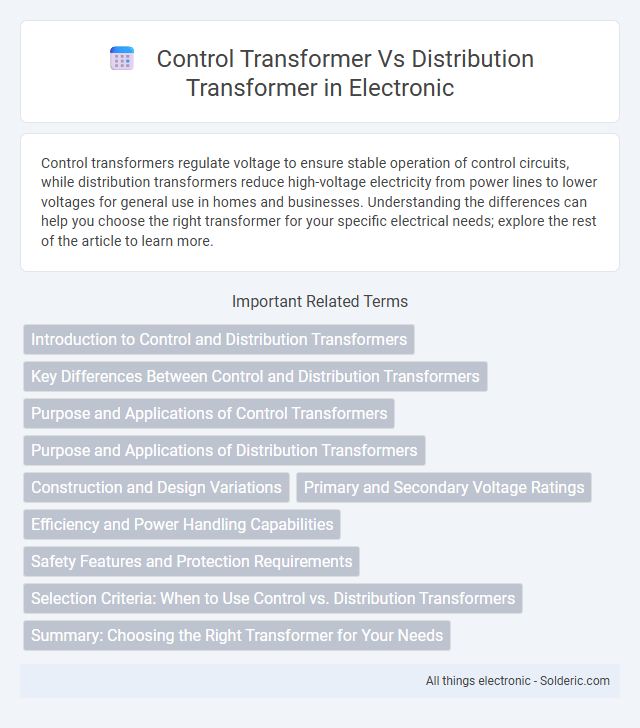Control transformers regulate voltage to ensure stable operation of control circuits, while distribution transformers reduce high-voltage electricity from power lines to lower voltages for general use in homes and businesses. Understanding the differences can help you choose the right transformer for your specific electrical needs; explore the rest of the article to learn more.
Comparison Table
| Aspect | Control Transformer | Distribution Transformer |
|---|---|---|
| Purpose | Supplies power to control circuits and instrumentation | Steps down voltage for general power distribution |
| Voltage Rating | Low voltage, typically 120V or 240V secondary | High to low voltage, commonly from 11kV/33kV down to 400V/230V |
| Power Rating | Small, typically 50 VA to 500 VA | Large, ranging from several kVA to MVA |
| Design | Compact, designed for limiting short circuit current | Robust, designed to handle full load current continuously |
| Cooling | Usually dry type with natural air cooling | Oil-immersed or dry type with various cooling methods |
| Application | Control panels, relay protection, automation systems | Power distribution in residential, commercial, and industrial areas |
Introduction to Control and Distribution Transformers
Control transformers provide stable and reduced voltage specifically for control circuits in industrial equipment, ensuring reliable operation of relays, timers, and contactors. Distribution transformers handle higher power loads, stepping down primary voltage from utility lines to usable levels for residential or commercial power distribution. Both types optimize electrical system performance by tailoring voltage levels to specific application requirements, improving safety and efficiency.
Key Differences Between Control and Distribution Transformers
Control transformers are designed to provide stable voltage for control circuits in industrial equipment, handling lower power levels typically below 5 kVA. Distribution transformers serve as essential components in power distribution networks, stepping down high voltage to usable levels with power ratings ranging from a few kVA to several MVA. Unlike distribution transformers, control transformers feature enhanced voltage regulation and isolation to protect sensitive control devices.
Purpose and Applications of Control Transformers
Control transformers are designed to provide a stable voltage supply to control circuits in machinery and automation systems, ensuring precise and reliable operation of relays, contactors, and timers. They are commonly used in industrial control panels, HVAC systems, and manufacturing equipment to step down voltage for low-power control devices without affecting the main power flow. Your control systems benefit from their ability to handle short-term overloads and deliver regulated voltage essential for consistent performance and safety.
Purpose and Applications of Distribution Transformers
Distribution transformers are designed to step down high voltage from the distribution network to a lower voltage suitable for residential, commercial, and industrial use, ensuring safe and reliable power delivery. They are commonly installed near end-users to supply electricity for lighting, heating, and office equipment, supporting daily energy demands efficiently. Unlike control transformers, which provide stable voltage for control circuits, distribution transformers handle large power loads for general electrical distribution.
Construction and Design Variations
Control transformers are designed with smaller cores, low-voltage windings, and precise taps to deliver stable control voltages while minimizing electrical noise. Distribution transformers feature larger cores and thicker windings to handle high power loads and efficiently step voltage levels for electric grids. Your choice depends on whether the application requires precise voltage regulation in control circuits or high-capacity voltage conversion for power distribution.
Primary and Secondary Voltage Ratings
Control transformers typically have lower primary voltage ratings, often designed for standard control circuit voltages such as 120V or 480V, and secondary voltage ratings that provide safe control voltages like 24V or 120V. Distribution transformers feature higher primary voltage ratings, commonly ranging from 2.4 kV to 34.5 kV, with secondary voltages usually at 120/240V or 277/480V to supply residential or commercial loads. The voltage ratings of both transformers are selected based on their specific applications, with control transformers optimized for precision control circuits and distribution transformers engineered for broader power delivery.
Efficiency and Power Handling Capabilities
Control transformers exhibit higher efficiency in low-power applications, optimizing voltage regulation and minimizing energy loss during equipment startup and control circuits. Distribution transformers handle significantly larger power loads with robust core designs, maintaining efficiency above 95% even at high load levels to ensure reliable power delivery across residential and industrial networks. Their power handling capabilities prioritize sustaining continuous energy flow, whereas control transformers specialize in precise voltage control within limited power ranges.
Safety Features and Protection Requirements
Control transformers incorporate enhanced safety features such as isolation windings and thermal protection to prevent overloads and electrical faults, ensuring stable voltage supply to control circuits. Distribution transformers prioritize robust protection mechanisms including surge arresters, fuses, and protective relays to safeguard against short circuits, overloads, and lightning strikes in power distribution networks. Both transformers adhere to stringent industry standards like IEEE C57 and IEC 60076, emphasizing reliable insulation, grounding, and temperature monitoring for operational safety.
Selection Criteria: When to Use Control vs. Distribution Transformers
Control transformers are selected for applications requiring low-voltage control circuits with stable voltage and minimal electrical noise, making them ideal for industrial control panels and automation systems. Distribution transformers are designed to handle high voltage regulation and power distribution over long distances, suitable for delivering electricity from substations to residential or commercial areas. Your choice depends on whether the priority is precise voltage control in machinery (control transformer) or efficient power delivery at varying loads (distribution transformer).
Summary: Choosing the Right Transformer for Your Needs
Control transformers provide stable voltage to control circuits, ensuring precise operation of machinery and equipment. Distribution transformers primarily step down high voltage to lower levels for efficient power distribution across residential, commercial, and industrial areas. Your choice depends on whether you require voltage regulation for control systems or large-scale power distribution, optimizing performance and safety.
control transformer vs distribution transformer Infographic

 solderic.com
solderic.com